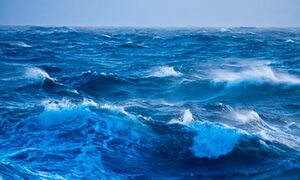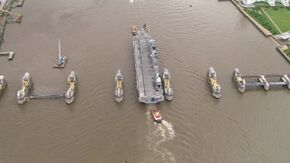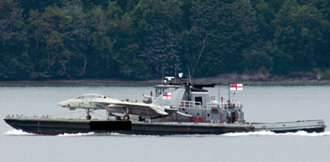HMS Ocean
HMS Ocean is the only active helicopter assualt ship in the Royal Navy. She is fully equipped with helicopters and landing craft and golf buggies for a full-scale, amphibious landing force. This would be ideal if, say, a British colonial island somewhere in the Caribbean experienced a tropical storm. Combined with all the other landing assault ships in the Royal Naval fleet (to-wit: the HMS Bulwark), a total assault force could number 800 men with 20 helicopters, more than enough to dispatch the whole might of the Chinese military.
Design[edit]
HMS Ocean was originally designed as a ferry. This was simply a small prank on the contractor, as the government believed it could order a "military ferry" for less money than an "aircraft carrier." Halfway through construction, the Ministry of Defence changed the specifications, suddenly adding a car park on the top deck for the cars of the assault troops. The contractors fell for this and the government got a landing strip on the cheap, declaring the resulting ship an aircraft carrier.
Immediatly after her launch, the Royal navy encountered a problem with Ocean's design, as the car park required several stories and took most of the space from a planned hangar in which to store the aircraft, and designated parking spaces for the disabled took the rest. Moreover, the ski-ramp designed to impart lift to departing planes was omitted as well and replaced with stairs down to the shopping mall.
The Ministry of Defence faced embarrassment in explaining this cumbersome outcome to the public, as Rube Goldberg was, after all, a Yankee. The solution was to claim that the Ocean was no "aircraft carrier" at all but the first-ever "helicopter platform assualt ship." The Opposition in Parliament tried to ask, "Do we need that?" but the cat-calls from government were deafening. The public were advised that the huge car park could store all 17 tanks in the British army and 400 men. The rampless flat flight deck was perfect for helicopter landings and so the unprecedented new class of ship was completely justified.
Role[edit]
HMS Ocean's role is to sit around in a British harbour, near the entrance, all tidy and clean, to look as though Britain is still actively defended with an aircraft carrier. It is not allowed out of the port into the open sea, as it might get damaged and then Britain would be left without a helicopter carrier.
In wartime, she could land an assualt force of 400 marines on a beach along with 20 helicopters. They would charge out through a huge door in the transom at the back of the ship. However, the door proved to be a single-use exit, as once opened, sea water pours in and the ship sinks.
Operational history[edit]
In 2008, HMS Ocean received the Portsmouth honour to add to their crest, presented by the Duke of York, for staying in Portsmouth harbour and continuing to defend the harbour against the threat of Viking raids along the South Coast which, as yet, have not occured. The government assured the nation that this threat is very real and that it is because of this threat that HMS Ocean must not leave the harbour. If it were to do so, Vikings/Pirates/Normans could immediately invade.
In 2011, HMS Ocean was not sent to Libya in response to the Arab Spring and the uprisings against Colonel Gaddafi. This was merely a rumour the media manufactured to ridicule the Ministry of Defence's policies and strategies. For example, the supposed capture of SAS soldiers by Gadaffi forces, when flying in a helicopter from HMS Ocean over Libya, never occured. HMS Ocean did not send helicopters to fly over Libya to fire missiles into the Libyan government's military installations. HMS Ocean never went anywhere near Libya. Britain provided no military support at all for the Libyan rebels. Surely that will clear things up.
In 2012, HMS Ocean attempted its most dangerous and fearful operation ever. Nicknamed Operation Impossible by the Lord High Admiral, who could barely contain his laughter, HMS Ocean was to travel up the Thames to support the Mayor of London in squashing the "plebs," and to use its helicopters to gun down any revolting underclasses. Passage through the Thames Barrier (the "Thames Barrier Manouver") remains the most dangerous manouver in modern Royal Navy history. HMS Ocean scraped past the gates and made it through, saving the Royal Navy a few hundred million pounds and reducing its weight by roughly the same figure.
War capability[edit]
HMS Ocean is technically able to go to war. However, in practice, this would be difficult, as HMS Ocean has not sailed for years due to the high fuel costs. The Ocean claims to be ready to see action in only 30 days after being called up. The Navy would use this time to conduct raids ashore to kidnap the crew and sign the UK Border Agency leaflets before leaving harbour.
She is capable of conducting air operations in a war situation any time there is a gentle breeze and a swell not exceeding 0.5m. Without anti-air, anti-submarine, or anti-ship protection, she requires a destroyer to escort her.
Planes Aircraft[edit]
HMS Ocean can carry 20 Merlin helicopters (each with a full complement of 50 Mordred paper-clip shooters), 10 Chinook helicopters or as the crew discovered to their delight 5 thousand tonnes of solid gold stolen from Spanish merchant ships. These helicopters are easily out-manoeuvred by jets and can be destroyed in seconds. A classified report recently leaked to the media disclosed that Defence believes helicopters are useless in naval combat situations and that their only role now is to search for submarines, transport men, or beachcomb for metal objects that might be recycled for cash. Therefore, HMS Ocean's combat role would be to sit like a duck and provide a target for the incoming jet fighters, proudly flying the Union Jack and doing the UK proud.
Other weaponry[edit]
HMS Ocean's weapons, apart from those on the aircraft, are four miniguns and a phalanx. These weapons, though primitive, would be ideal for the case of attack by pirates armed with swords. Victory would be assured if only 20% of them had wooden arms ending in hooks. Defence believes that fighter jet attacks are vanishingly unlikely and the most probable threat against HMS Ocean would be an enemy ship approaching and firing cannons broadside.
The miniguns are machine guns put on the sides to deter pirates. Though they would not pierce an enemy ship's armour, the sound of the bullets pinging off the sides would cause attackers great stress. The miniguns also provide entertaining target practice during pretend battles.
The phalanx weapon is well-known for protecting British destroyers in the Falklands War from Argentine air attacks as the destroyers sank to their graves. The phalanx on HMS Ocean was supposed to be replaced with a goalkeeper in 2003, another casualty of funding cuts. It is the most modern version of a maxim gun and blasts hundreds of rounds of bullets roughly in the direction of incoming jet fighters, until it jams after 50-odd rounds.


